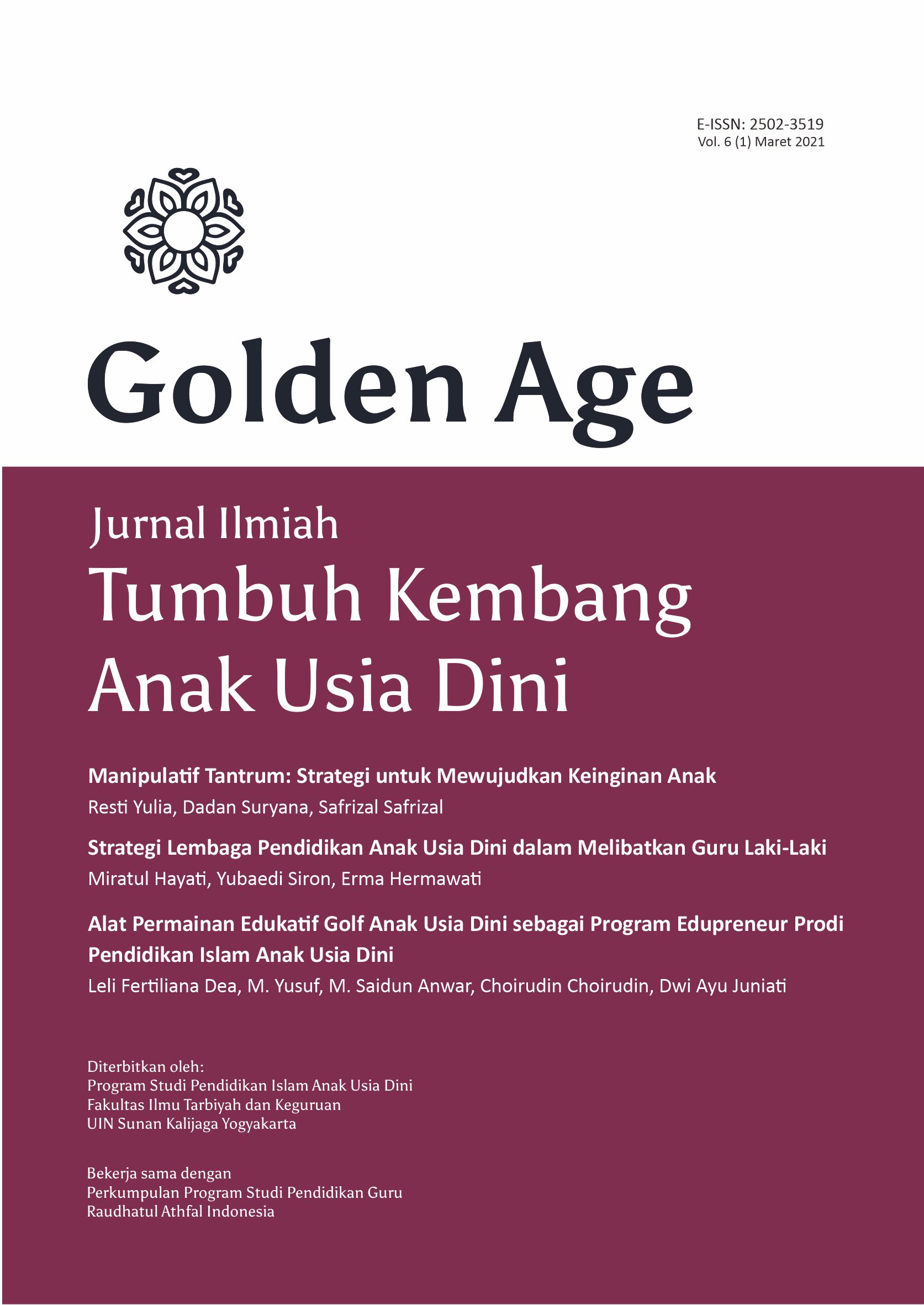1404
Views
1477
Pdf Bahasa Indonesia Views
 Open Access
Open Access
Pencegahan Perilaku Agresif Anak Usia Dini dengan Bernyayi dan Menari
Main Article Content
Abstract
The purpose of this study was to determine the dynamics of singing and dancing techniques in preventing aggressive behavior in early childhood. This research uses descriptive qualitative research methods. The subjects of the study were students or children who behaved aggressively in PAUD Al-Adiba institutions, Blitar. Data collection was carried out by several methods, namely observation, interviews, and documentation study. The results of the data were analyzed using a grounded theory analysis approach model. The results showed that the aggressive behavior of the children of PAUD Al-Adibal Blitar, among others: beatings, screaming, crying, etc. were caused by factors of parenting, social environment, and genetics. Singing or dancing techniques can be used by teachers in overcoming children's aggressiveness. As much as 80% of early childhood education learning activities are used for singing and dancing for each material. So that singing and dancing can be used as a means of preventing aggressive behavior at PAUD Al-Adiba Blitar from an early age.
Keywords:
Downloads
Metrics
Article Details
How to Cite
Copyright
Copyright Notice
Authors who publish with this journal agree to the following terms:
- Authors retain copyright and grant the journal the right of first publication with the work simultaneously licensed under a Creative Commons Attribution-NonCommercial 4.0 International License that allows others to share the work with an acknowledgment of the work's authorship and initial publication in this journal, provided that the work is not used for commercial purposes.
- Authors can enter into separate, additional contractual arrangements for the non-exclusive distribution of the journal's published version of the work (e.g., post it to an institutional repository or publish it in a book), with an acknowledgement of its initial publication in this journal.
- Authors are permitted and encouraged to post their work online (e.g., in institutional repositories or on their website) prior to and during the submission process, as it can lead to productive exchanges, as well as earlier and greater citation of published work.
Privacy Statement
The names and email addresses entered in this journal site will be used exclusively for the stated purposes of this journal and will not be made available for any other purpose or to any other party.
References
Allen, J. J., & Anderson, C. A. (2017). Aggression and Violence: Definitions and Distinctions. In The Wiley Handbook of Violence and Aggression. https://doi.org/10.1002/9781119057574.whbva001
Arriani, F. (2014). Perilaku Agresif Anak Usia Dini. JPUD: Jurnal Pendidikan Usia Dini, 8(2), 263-274. Retrieved from http://journal.unj.ac.id/unj/index.php/jpud/article/view/3589
Cabello, R., Gutiérrez-Cobo, M. J., & Fernández-Berrocal, P. (2017). Parental Education and Aggressive Behavior in Children: A Moderated-Mediation Model for Inhibitory Control and Gender. International Journal Frontiers in Psychology, 8, 1–8. https://doi.org/10.3389/fpsyg.2017.01181
Chatzihidiroglou, P., Chatzopoulos, D., Lykesas, G., & Doganis, G. (2018). Dancing Effects on Preschoolers’ Sensorimotor Synchronization, Balance, and Movement Reaction Time. Perceptual and Motor Skills, 125(3), 463–477. https://doi.org/10.1177/0031512518765545
Dewi, K. S., Prihatsanti, U., Setyawan, I., & Siswati. (2015). Children’s Aggressive Behavior Tendency in Central Java Coastal Region: The Role of Parent-Child Interaction, Father’s Affection and Media Exposure. Procedia Environmental Sciences, 23, 192–198. https://doi.org/10.1016/j.proenv.2015.01.030
Elmer, S. S. (2011). Human Singing : Towards a Developmental Theory. Psychomusicology: Music, Mind and Brain, 21(1-2), 13-30. https://doi.org/10.1037/h0094001
Fadlillah, M. (2012). Desain Pembelajaran PAUD. Ar-Ruzz Media.
Febriana, P., & Situmorang, N. Z. (2019). Mengapa Remaja Agresi?. Jurnal Psikologi Terapan dan Pendidikan, 1(1), 16-21. https://doi.org/10.26555/jptp.v1i1.15128
Gudmundsdottir, H., & Trehub, S. (2017). Adults Recognize Toddlers’ Song Renditions. Psychology of Music, 46(2), 281–291. https://doi.org/10.1177/0305735617711762
Hanurawan, F. (2019). Psikologi Sosial Suatu Pengantar. PT. Remaja Rosdakarya.
Hardani, H., Medica, P., Husada, F., Andriani, H., Sukmana, D. J., & Mada, U. G. (2020). Buku Metode Penelitian Kualitatif & Kuantitatif. Pustaka Ilmu.
Hillis, S., Mercy, J., Amobi, A., & Kress, H. (2016). Global Prevalence of Past-year Violence Against Children : A Systematic Review and Minimum Estimates. Pediatrics, 137(3). https://doi.org/10.1542/peds.2015-4079
Latif, M. (2013). Orientasi Baru Pendidikan Anak Usia Dini. Kencana Prenada Media Group.
Marisa, C., Fitriyanti, E., & Utami, S. (2018). Hubungan Pola Asuh Orang Tua dengan Motivasi Belajar Remaja. Jurnal Konseling dan Pendidikan, 6(1), 25-32. https://doi.org/10.29210/118700
Muliawan, J. U. (2016). Model Pembelajaran Spektakuler. Ar-Ruzz Media.
Myers, D. G. (2012). Psikologi Sosial. Salemba Humanika.
RI, K. A. (2020). Al-Qur’an dan Terjemahnya. Yayasan Penyelenggara Penterjemah/Pentafsir Al-Qur’an.
Shihab, M. Q. (2017). Tafsir Al-Misbah Pesan Kesan dan Keserasian Al-Qur’an. Lentera Hati.
Siddiqah, L. (2015). Pencegahan dan Penanganan Perilaku Agresif Remaja Melalui Pengelolaan Amarah (Anger Management). Jurnal Psikologi, 37(1), 50–64. https://doi.org/10.22146/jpsi.7692
Supratiknya. (2012). Mengenal Perilaku Abnormal. Kanisius.
Supriatna, E. (2012). Implementasi Pembelajaran Sejarah yang Berbasis Religi dan Budaya di Kawasan Banten Lama: Suatu Kajian Transformatif Nilai-nilai Religi dan Budaya dalam Pendidikan Sejarah di SMA. Universitas Pendidikan Indonesia.
Suyono. (2011). Belajar dan Pembelajaran. Remaja Rosdakarya.
Suyanto, S. (2016). Kurikulum PAUD dan Implementasinya dalam Pembelajaran. FMIPA UNY.
Türkoğlu, B. (2019). Preschool Teachers’ Perspectives on Aggressive Behaviors in Children: A Qualitative Study. Journal of Education and Training Studies, 7(2), 169-183. https://doi.org/10.11114/jets.v7i2.3889
Uce, L. (2015). The Golden Age: Masa Efektif Merancang Kualitas Anak. Jurnal Pendidikan Anak: Bunayya, 1(2), 77–92.
WHO. (2020). Violence Against Children. WHO. https://www.who.int/news-room/fact-sheets/detail/violence-against-children
Wiyani, N. A. & B. (2014). Format PAUD Konsep, Karakteristik & Implementasi Pendidikan Anak Usia Dini. Ar-Ruzz Media.
YPMNU. (2013). Proposal Pembangunan PAUD Al-Adiba. Yayasan Pendidikan Muslimat NU.
Yuliani, R. (2013). Emosi Negatif Siswa Kelas XI SMAN 1 Sungai Limau. Jurnal Ilmiah Konseling, 2(1), 151-155. https://doi.org/10.24036/0201321883-0-00




